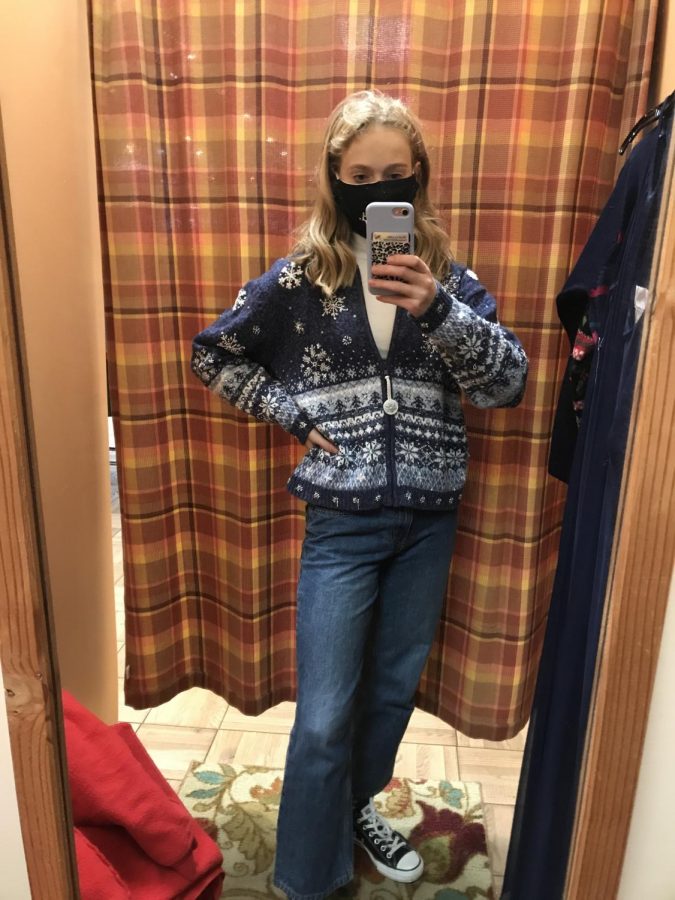Thrifting rises in popularity amongst teens
Junior Callie Burd poses in the dressing room of a thrift store with her new finds. Burd has been thrifting for almost three years and loves finding unique items and being eco-friendly.
December 11, 2020
The thrill of buying new clothes, a so-called “shoppers high,” may have a short-term benefit on your mind, but is not always good for your pockets or the environment. With thrifting on the rise, consumers have found a cheap and sustainable alternative to shop.
“I started thrifting around three years ago because I thought it would be a fun way to find new clothes and also be more environmentally friendly when it comes to fashion,” junior Callie Burd said. “It’s also a great way to hang out with friends, although most of the time I go thrifting with my mom.”
Burd enjoys the creative freedom that comes with thrifting. She often buys clothes that are a little too big and turns them into outfits for different occasions.
“The majority of my wardrobe consists of clothes that I have thrifted and clothes that I have sewn, ” Burd said. “If I see a fabric or a design I like, I can alter it or combine it with something else or even make something new.”
Sophomore Kaylen Chang is the co-founder of the Fashion Club at WCHS and is also an avid thrifter. She has been thrift shopping for two years after seeing people on Instagram and YouTube do it.
“Thrifting is on the rise because of it’s generally low prices and unique finds. It’s awesome how when you thrift, you can save a piece of clothing from the landfill,” Chang said.
One of the major attractions of thrifting is its benefits on the environment. Each year, the average American throws away about 81 pounds of clothing, according to the Saturday Evening Post. Not only is the clothing being wasted, but the amount of resources that were used to make it, such as water, are also wasted. Donating these items to thrift stores gives them another chance to be worn.
“My favorite part about thrifting is simultaneously saving the earth when you’re shopping. Every time you buy something, you prevent it from being sent to a landfill or even incinerated,” Chang said.
Chang is an intern at The Sustainable Socialite, an thrift store where she gets to learn about vintage clothes and environmentally friendly fashion.
“It’s my first internship, and it’s helped me with finding genuine vintage clothes or fixing up old shirts into something new. I’ve gotten to create content, sell at markets, and learn so much,” Chang said.
Thrifting also combats fast fashion. Fast fashion is affordable, trendy clothes created by businesses through unethical sources. According to fashionchecker.org, 93 percent of brands surveyed do not pay their workers a livable wage and often overwork them. Not only this, the items are usually poorly made so they do not last long after trends die.
Thrifting offers top brands at affordable prices. Some stores like “Uptown Cheapskate” in Rockville are known as consignment stores, where they buy name brand items from thrifters and resell them for a much lower price than the brand itself.
Many even sell some of their top finds on popular online shops like Depop and Poshmark. Although it is a good way for teens looking to make some extra cash, some worry this can lead to the gentrification of thrift stores and cause a potential rise in prices.
“Especially on the resell app Depop, there are times when people resell clothes for a lot more just to profit,” Chang said. “People in thrift stores don’t always go for fun or the vintage look, but because the prices are the only ones affordable.”
COVID-19 has not helped thrift stores either. Just like other small businesses, thrift stores have been hit badly by the pandemic.
“A lot of people are scared to touch old clothes or simply go into a thrift store because they want to stay healthy,” Chang said. “Thrift stores already have a stereotype of dirty, unorganized, and adding COVID didn’t make it any better.”
Chang recommends online thrift stores such as Vinted, Good Fair and Objected Limited for those who are buying clothes during the pandemic, though they do not have the same thrill as going in person.
“I really miss going to stores, especially with friends, because it shows them just how much clothes are donated and wasted after a few uses,” Chang said. “It’s also so much fun to see each unique piece on every rack because different stores have different items and it’s a good way to get out of the house.”
Burd recommends new thrifters look for some inspiration before heading in, but not to be too hung up on looking for a particular thing.
“Sometimes I have certain items in mind, but it’s often really difficult to find specific items. I usually end up finding things I wasn’t even looking for,” Burd said. “Thrift stores can be very hit or miss, so you have to go in with an open mind.”


